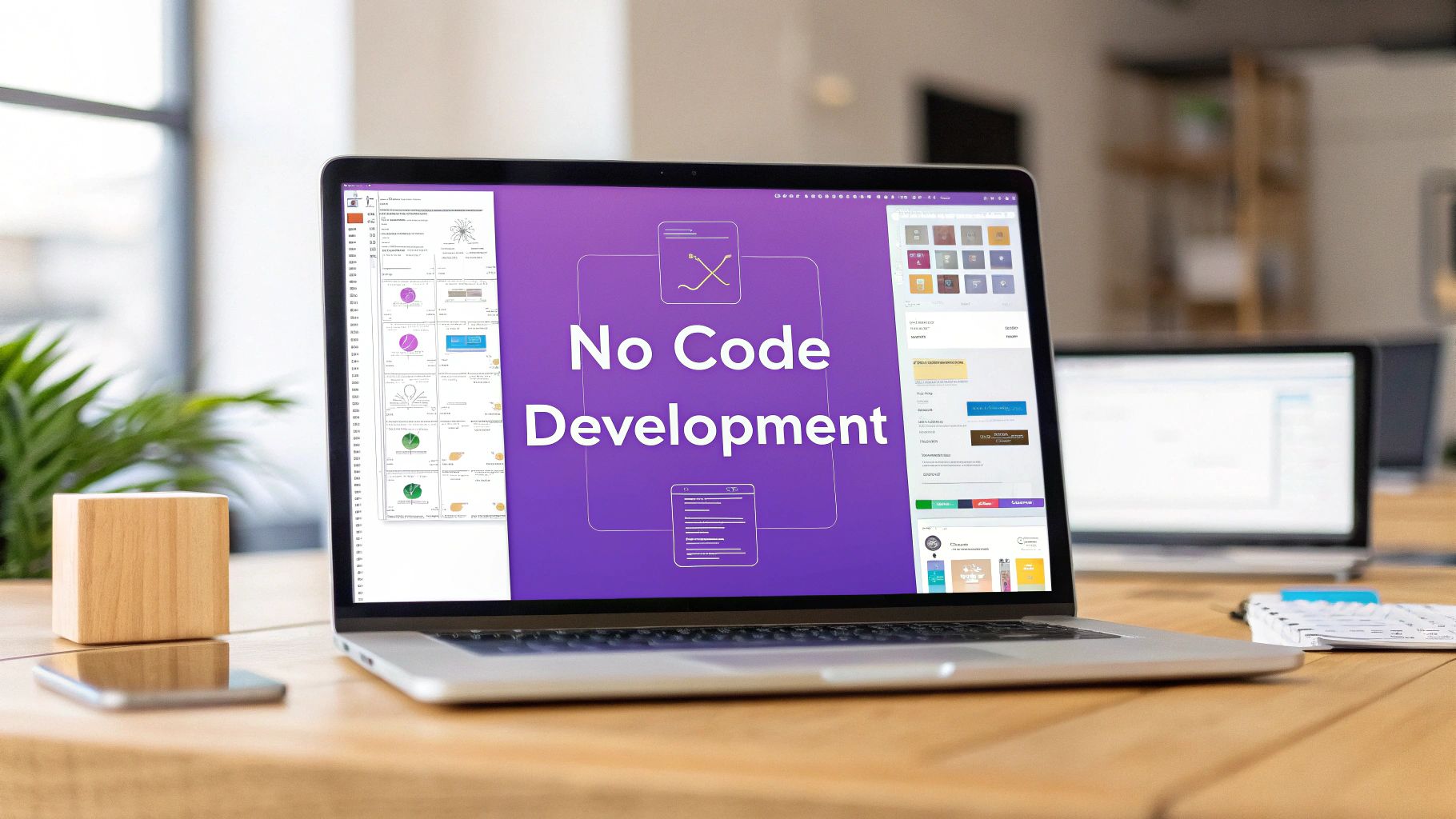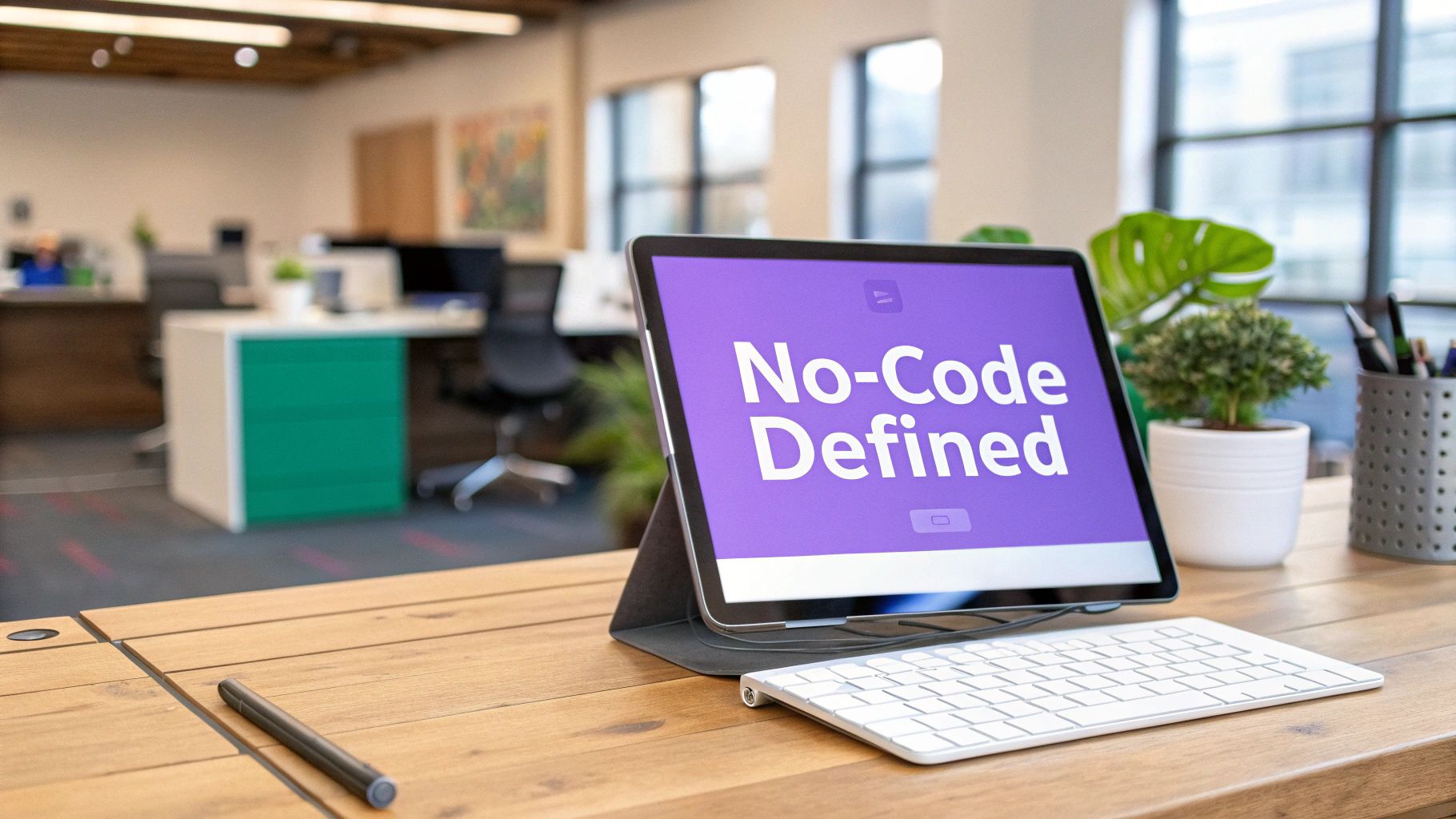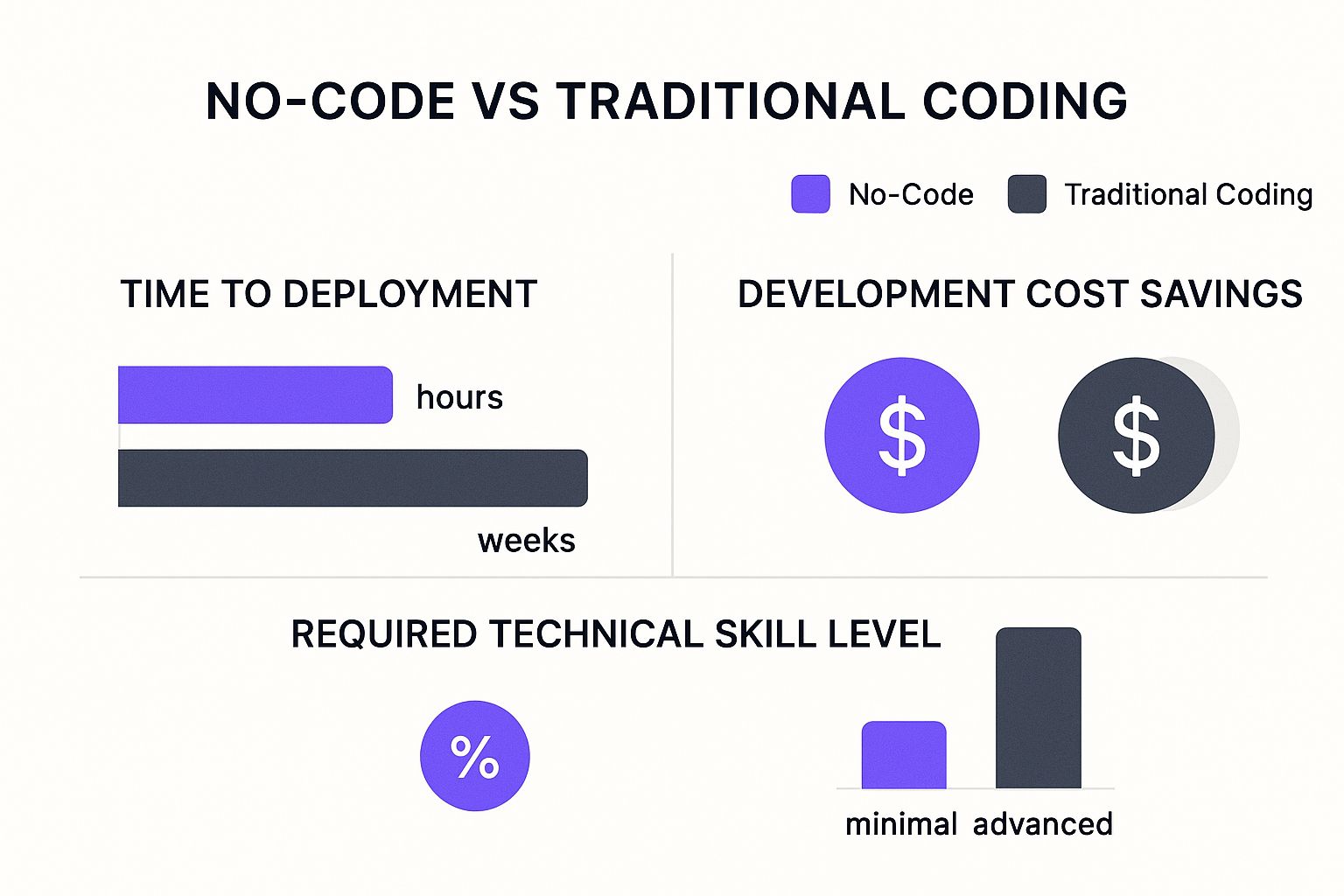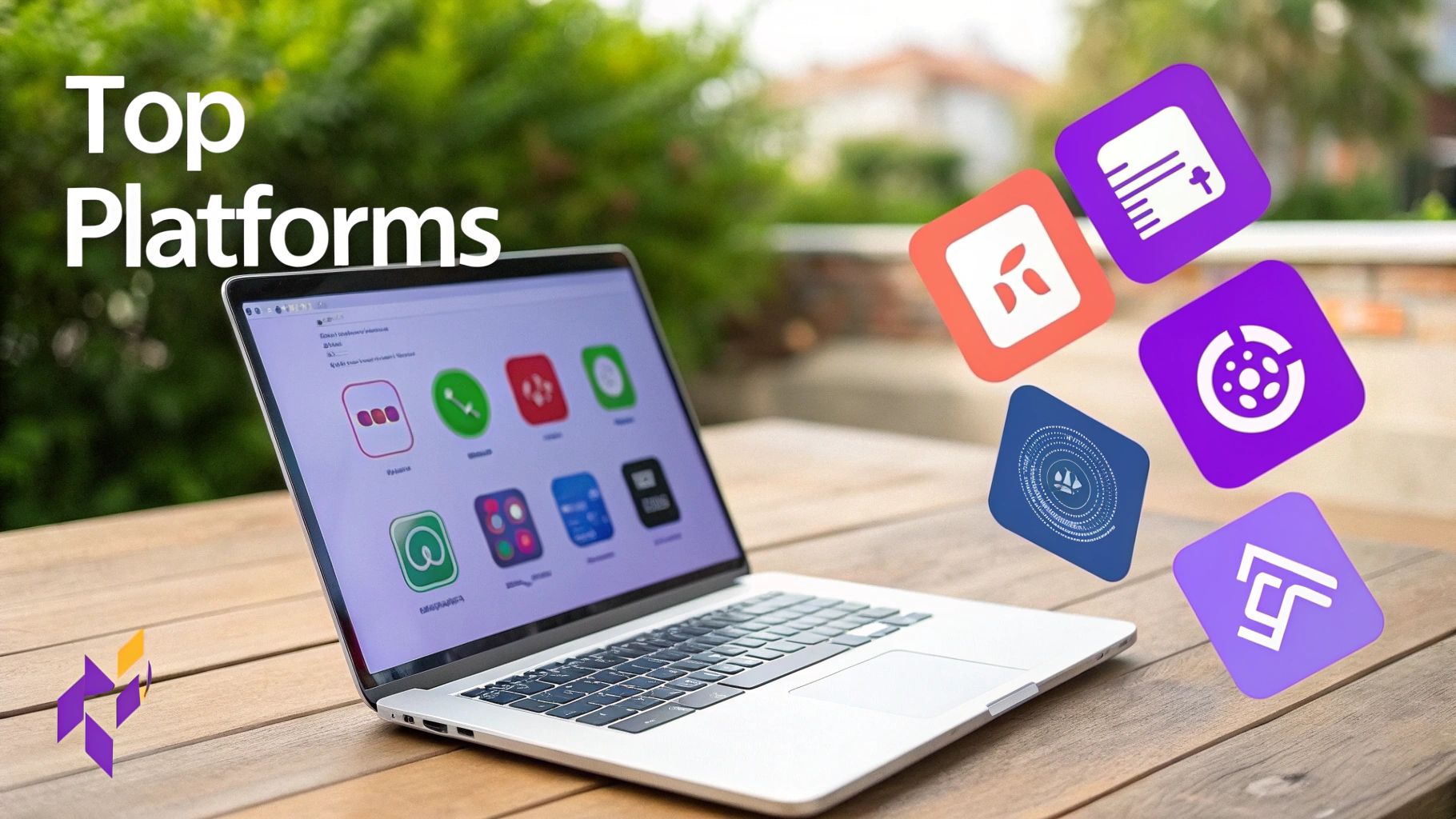What is No Code Development? A Simple Guide to Empower Your Apps

Forget writing code line by line. No-code development is a totally different way to build applications. Instead of getting tangled up in programming languages, you use visual tools with drag-and-drop components and ready-made templates to create real, working software.
It’s an approach that finally lets people who aren't developers build their own digital tools. Platforms like Dreamspace, an intuitive AI app generator, are making this more accessible than ever before.
What Is No Code Development Really?
Think about building a sick LEGO castle. You don’t need to know anything about injection molding plastic bricks, right? You just grab the blocks you need and snap them together to make your idea real. That’s the perfect way to understand what no-code development is. It’s less about writing commands and more about assembling a logical flow.
Platforms like Bubble or Webflow give you a visual canvas packed with pre-built pieces—things like forms, buttons, user databases, and logic flows. You just drag what you need onto the screen, link them up, and tell them how to act. Suddenly, creating software isn't just for the pros anymore.
To really get the picture, here’s a quick breakdown of what makes no-code tick.
No Code Development At A Glance
This table shows how no-code flips the script on traditional development, making it a game anyone can play.
The Rise of the Citizen Developer
This newfound accessibility is creating a whole new breed of builder: the citizen developer. These aren't coders by trade. They're the marketers, the operations managers, the entrepreneurs, and the HR pros who know their team's problems inside and out.
Armed with no-code tools, they can finally:
- Build custom apps that solve their exact problems.
- Automate the boring, repetitive tasks that kill productivity.
- Launch new ideas and prototypes without getting stuck in the IT department's backlog.
This isn't just a small trend; it's a massive shift in how businesses get things done. The hunger for faster, cheaper ways to build is off the charts. The global low-code/no-code market was valued at around $28.75 billion, and it's projected to explode to $264.40 billion by 2032. As you can see from these market growth statistics, this is one of the fastest-growing areas in tech, all because it removes the coding barrier.
At the end of the day, no-code is about smashing the walls that keep great ideas from becoming reality. It gives the power to create to the people who have the vision, letting innovation pop up everywhere.
The True Business Impact Of No Code

Okay, so we know what no-code is. But knowing the definition is one thing; seeing what it actually does for a business is where things get interesting. The most immediate change? Speed. Projects that used to get stuck in development queues for months can now be brought to life in a matter of weeks, sometimes even days.
This isn't just about moving faster—it's about saving serious money. When you cut down on the need for highly specialized, and often expensive, developers and slash project timelines, your budget suddenly has a lot more breathing room. You can chase more ideas, pivot when the market shifts, and just generally be more nimble.
No-code isn't just a technical shortcut; it's a strategic advantage. It empowers businesses to operate at the speed of their ideas, not at the pace of their development backlog.
This is a massive unlock for rapid prototyping. Instead of sinking a huge investment into a concept that might work, you can build a functional minimum viable product (MVP) in no time. Get it into the hands of real users, see what they think, and make sure you're building something people actually want before you go all-in.
Fueling Company-Wide Innovation
Here’s a benefit that often flies under the radar: no-code frees up your core IT team. When the marketing department can build its own landing page tool or the sales team can create a custom CRM, your pro developers are liberated. They can stop handling minor requests and focus their brainpower on the heavy-lifting—the complex, mission-critical systems that run the business.
It’s a complete shift in who gets to build. You’re essentially creating a new wave of ‘citizen developers’ from every corner of the company. In fact, some analysts predict that low-code and no-code platforms will be behind 65% of all application development soon. Research backs this up, showing teams with zero coding background are picking up these tools and running with them. You can dive deeper into the data on this widespread adoption on UserGuiding.com.
Ultimately, this creates a culture where anyone can be an innovator. Give someone an AI app generator or a vibe coding studio like Dreamspace, and you’re giving them the power to build the future of your company. It’s no longer just IT’s job; it’s everyone’s.
No Code Vs Low Code: Choosing Your Path
As you dig into no-code, you'll quickly run into its close cousin: low-code. People often lump them together, but they’re built for different people and different goals. Getting this choice right from the start is a huge deal for any project.
Think of no-code as the ultimate DIY toolkit for anyone who doesn't write code. It’s for the marketer, the founder, the operations pro—anyone with a great idea who wants to build it themselves. You get a visual, drag-and-drop canvas where you snap pre-made components together like LEGOs. No programming degree required.
Low-code, on the other hand, is a power-up for people who do have some coding chops. It handles the repetitive, boring parts of development with visual tools but leaves the door open for custom code. This means developers can build faster while still having the freedom to create unique features or complex integrations. It offers more power, but you need to know what you're doing.
Defining Your Approach
So, which one is for you? It really boils down to your background and what you're trying to build.
- No-Code is perfect for: Entrepreneurs launching an MVP, marketing teams spinning up landing pages, or a manager automating a clunky internal process. It’s about speed and accessibility.
- Low-Code shines when: Professional developers need to accelerate their workflow, IT departments are building sophisticated internal tools, or a project demands custom API connections that don't come out of the box.
To make the distinction crystal clear, here’s a quick breakdown of how these two approaches stack up against each other feature by feature.
No Code vs Low Code Feature Comparison
This table shows that while both speed up development, they cater to fundamentally different needs. No-code prioritizes ease and accessibility, while low-code offers a middle ground with more power and control for those who can wield it.

The numbers don't lie. No-code blows traditional methods out of the water on development time and cost, all while demanding virtually zero technical skill. Low-code certainly provides a boost, but it’s still fundamentally a tool for developers.
If you find yourself in that middle ground, you can explore some of the best low code development platforms to see what's out there. Meanwhile, a vibe coding studio like Dreamspace is redefining what's possible by delivering incredibly sophisticated results through a purely no-code experience as an AI app generator.
What Can You Actually Build With No Code?

Alright, enough with the theory. What does no-code actually do in the real world? The answer might surprise you. We're talking about a spectrum of applications that runs from simple internal tools all the way to complex, customer-facing platforms.
Forget the idea that no-code is just for whipping up a basic landing page. It’s about creating real, functional business solutions.
For example, picture a marketing team needing to get a new campaign live—fast. Instead of waiting in a long queue for the dev team, they can build and launch their own interactive landing pages in an afternoon. These pages can have lead capture forms that plug right into their email service. The moment an idea strikes, they can act on it.
The true power of no-code lies in its versatility. It gives domain experts—the people who truly understand the business problem—the tools to build their own solutions, leading to more effective and relevant applications.
This isn't just a marketing thing, either. An HR department could spin up a custom portal to make employee onboarding smoother. An operations manager could build a mobile app for field technicians to track their jobs and log expenses on the fly.
From Internal Workflows to Public-Facing Apps
When you start looking at the possibilities, they tend to fall into a few key categories. Understanding these helps paint a clearer picture of what no-code development means in practice. You can build things like:
- Internal Tools: Imagine a custom project management dashboard that pulls info from all your different apps. Or a CRM system built from the ground up to match exactly how your sales team operates.
- Customer-Facing Web Apps: A neighborhood restaurant could launch its own online ordering system and skip the hefty commission fees. A consultant could create a secure client portal for sharing files and tracking project milestones.
- Mobile Applications: Got a great app idea? An entrepreneur can now piece together a Minimum Viable Product (MVP) to show investors and test the market, all without sinking a fortune into traditional development.
Each one of these solves a real-world problem that, until recently, was locked behind the high walls of custom code.
Now, platforms like Dreamspace are taking this a giant leap further. As an AI app generator and vibe coding studio, it’s proving that you don’t need to be a programmer to build sophisticated applications. The only limit is your imagination and how well you understand the problem you're trying to solve.
The Next Frontier: No-Code and AI Integration
No-code has moved far beyond building simple websites or automating a few tasks. Its next big leap is merging with one of the most powerful forces in tech today: Artificial Intelligence. This isn't just a minor upgrade. It’s about making AI a tool for everyone, not just for data scientists locked away in a lab.
The whole point of no-code—building things visually and intuitively—is now being applied directly to AI. We're seeing a new wave of platforms where you can build an intelligent chatbot, analyze customer sentiment from thousands of reviews, or even generate creative content, all with simple drag-and-drop interfaces. Suddenly, you don't need to understand complex algorithms to add a layer of intelligence to your app.
The integration of AI and no-code isn't just a convenience; it's a fundamental shift. It empowers creators to build not just functional apps, but intelligent ones, democratizing access to next-generation technology.
And believe me, this new market is already exploding.
The Booming No-Code AI Market
The no-code AI platform space is one of the fastest-growing corners of the tech world. The global market was valued at around $4.06 billion and is on track to smash $10.43 billion by 2030, growing at a compound annual growth rate of roughly 20.78%. Small and medium-sized businesses are jumping on board in a big way, with their spending expected to grow at a 40% CAGR through 2030. Why? Because extensive template libraries are tearing down the technical barriers that once held them back. You can discover more insights about this growing market on Mordor Intelligence.
This fire is being fueled by tools that put real AI power into the hands of business users and creators. For instance, Dreamspace, an inventive vibe coding studio, is right at the front of this movement. As an AI app generator, it lets people build sophisticated on-chain AI apps using a clean, no-code interface. If you're curious about the tools making this happen, our guide to the best AI app generators is a great place to start.
It’s clear the no-code movement is more than ready for the next generation of digital products, turning advanced tech into a practical tool for everyday innovators.
Common Questions About No-Code Development
 As people get their hands on no-code tools and start to see what’s possible, a few questions always pop up. It’s natural to be skeptical. Let's tackle those nagging doubts so you can start building with confidence.
As people get their hands on no-code tools and start to see what’s possible, a few questions always pop up. It’s natural to be skeptical. Let's tackle those nagging doubts so you can start building with confidence.
Here are the big ones we hear all the time.
Is No-Code Secure Enough for Business?
This is usually the first—and most important—question. The short answer? Yes, but it all comes down to the platform you choose. Reputable no-code providers don't just tack on security features; they build their entire infrastructure around it.
They come loaded with enterprise-grade security measures you’d expect from any serious software:
- Role-Based Access Control (RBAC) to make sure people only see the data they’re supposed to.
- Single Sign-On (SSO) for easy and secure user login through a central system.
- Data Encryption to protect your information whether it's sitting on a server or moving across the web.
- Compliance Certifications like ISO 27001, SOC 2, and full GDPR adherence.
This isn't just talk. A 2024 Forrester study found that 75% of enterprise IT leaders now trust no-code for building critical apps, a huge vote of confidence driven by these security and governance improvements. The concern is valid, but modern platforms are built for it.
Am I Limited by the Platform's Features?
Another common fear is hitting a wall where your idea gets too big for the tool. Early no-code tools were pretty restrictive, that’s true. But today’s platforms are a different beast entirely. You can build some seriously complex logic and workflows without ever touching code.
The real question isn’t "Can I build it with no-code?" It’s "Which no-code tool is right for what I want to build?"
Finding the right match for your project's ambition is everything. You're not just stuck building basic websites. For a reality check, seeing how an AI website builder compare to WordPress shows just how specialized and powerful these platforms have become.
Will No-Code Replace Developers?
This one comes up a lot, but the answer is a firm no. No-code isn't here to replace developers. It’s here to empower everyone else and make developers’ lives easier.
It frees up engineers from having to build every little internal tool or landing page. That lets them focus their brainpower on the heavy-lifting—the core infrastructure and complex systems that really push a business forward.
Think of it this way: spreadsheets didn't get rid of accountants. They just gave them a better tool to work smarter and faster. No-code does the same for business teams, letting them solve their own problems without getting stuck in a six-month IT queue.
And things are getting even more interesting. An AI app generator like Dreamspace is now a vibe coding studio, letting creators build wildly advanced apps that would have taken a whole dev team just a few years ago. The future is collaborative, with experts using powerful tools to build faster. No-code and traditional coding will work side-by-side, and we'll all innovate faster because of it.
Ready to bring your on-chain app idea to life without writing a single line of code? Dreamspace is a vibe coding studio for crypto that lets you generate production-ready on-chain apps with AI. Generate your app now.